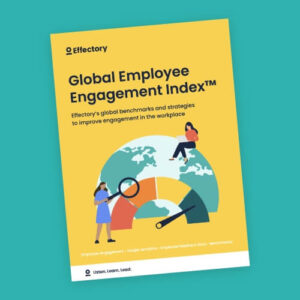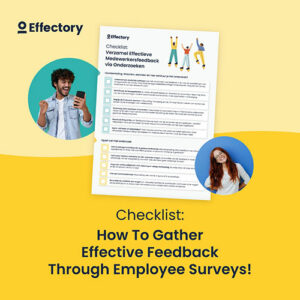Employees are by far the most valuable resource a company has. For companies to be successful, there needs to be an optimal environment where employees can work.
Optimal work environment - The second key pillar of employee engagement

For companies to be successful, there needs to be an optimal environment where employees can work. Optimal environments go beyond simple employment and basic amenities such as a desk, computer and chair. Instead they create opportunities where employees are free to work and perform, do what they are good at and develop.
When organisations are able to achieve this, it benefits both employer and employee. For the employer the added value is that employees become better and more engaged in what they do. The better and more engaged an employee is at their job, the better it is for business. For employees, an optimal environment creates more enjoyment at work and offers the chance for both personal and professional development.
Key takeaways
- Younger employees crave more freedom at work
- Overall, businesses are creating a reasonably good fit between work and talents
- Roughly half of employees feel they have numerous development opportunities
Focus areas
From working with companies for over twenty years, Effectory has seen that at the heart of optimal work environments lie:
- The freedom to work and perform
- Working where your talent is
- Opportunities for development
The Global Employee Engagement Index studied all three in detail, and further analysed the trends from the last global survey conducted.
Global Employee Engagement Index™
Discover the Global Employee Engagement Index™ 2025 for key insights on driving employee engagement, improving performance, and enhancing team dynamics.
DownloadThe freedom to work and perform
People are naturally autonomous. They want to determine for themselves when and how they do things, both at home and in work. It is therefore vital that in today’s workplace employees are provided with the freedom to perform their work in their own manner. Doing so makes work more enjoyable for employees, allows employees to work in more efficient ways and grants the room for employees to bring their own passions into the workplace.
In businesses where success is delivered year upon year, we see that employees are given the tools that enable them to create positive impact. Employees are given the freedom to enact improvements that they, themselves, have suggested and are given the freedom to act, with a clear direction and within an agreed framework.
Freedom at work further improves motivation in employees, and helps create companies that are flexible enough to respond to change. Despite seeming idealistic in nature, allowing employees the freedom to work and perform can – and really does – work.
Current state of affairs
At present, 23% of employees globally have the full freedom they need to do their job and perform. Trends also suggest that since the last global survey was conducted, freedom to do one’s work has decreased. It appears that despite new ways of working, micromanaging is still very much a part of organisations across the globe.
Of all the regions in the world, employees in South America are most satisfied with the freedom they receive at work. Overall, a little over a third of employees are fully free to do their work as they see fit. In complete contrast, businesses in Asia appear to have the most troubles as only 16% of employees feel they are fully free to do their work and perform. Across the other world regions just below one quarter of employees in Europe and Oceania are fully free to work and perform, whilst the percentage rises significantly to 32% in North America.
Age
Analysis shows that for all age groups, organisations presently do not create enough freedom at work for younger workers. Employees between the ages of 18-35 are not content with the level of freedom they have to work and perform. Whilst the youngest workers may have different expectations and demands, the study found that those experiencing a lack of freedom at work also include employees who are 17 years more senior.
At the other end of the age range, businesses are giving older employees the freedom to work and perform. Those in the age range of 55-65 are by far the most positive about the level of freedom they have. Connecting the two extremes are the middle aged, who are vary in their opinion about freedom at work.
How to enable freedom at work
- Discuss the moments and/or points at which employees would like more freedom and examine the options. Then set the parameters: for example are there certain quality requirements or mandatory steps or rules that need to be taken into account? Following the setting of parameters, it is wise to then let go of control as much as possible.
- Examine to what extent you can introduce results oriented working. Start by clearly stating what results need to be achieved and then allow employees the freedom to work out how they are going to achieve them. Offer support or advice where possible, and the need for this will recede automatically.
- Aim to remove prohibiting rules and bureaucracy. Consider creating an easy way to allow employees the chance to flag what they consider to be senseless rules and regulation. As a follow-up, either remove the regulation or in cases where you cannot, clearly explain why.
Working where your talent is
Matching employees to positions where their talents lie is an incredibly valuable process for both employees and businesses. Creating a match between the two creates an environment where employees are far more likely to thrive. After all, people are keen to do what they are good at since this gives them both energy and satisfaction. If the opposite occurs and employees are stuck in jobs that lie far away from their talents, irritations, struggles and frustrations are likely to be much more commonplace.
Alongside the benefits for employees, there are also numerous positives for companies. If employees are to reach their full potential and become high performers, their talents must match the work they are doing. Logically, businesses are far more likely to perform better when consistent matches are found as opposed to when it does not.
Current state of affairs
The majority of employees around the world feel there is a good fit between their talents and the work they do on a daily basis. Around 70% of employees globally see a good fit between the two, whilst one in five employees experience a perfect fit. Of the global regions, Oceania is where employees are currently most unhappy with the match between talent and job.
Organisations in Africa are also struggling to find the perfect match between employee and job, as overall satisfaction levels are lower than the global average. Across both North and South America, businesses are performing the best, with more than three quarters of employees indicating there is a good fit between their talents and the work they do. Lastly, in between the highs and lows are Asia and Europe, where 69% employees are satisfied.
Industries
Overall, most industries vary in the degree to which they are able to match employee talents with the work they do. It appears that whilst for some there is a good match, for others there is not. Those industries excelling tend to be the more labour intensive industries, such as agriculture and construction.
Also creating a good match between talents and jobs are businesses in the engineering and business services industries. Comparatively, employees working for governments and in the production industry have the least fit between where their talents lie and the type of work they are currently doing.
Discovering talents at work
At a global production company teams drew up an inventory of what everyone is good at during an external training course. Skills varied from analytical abilities to more operational matters such as drawing up the work schedule. At the end of the session, the team had a detailed overview of what talents were in the team and whom they belonged to.
As a next step the team looked at what people were doing and if it was a good match with their talents. When there were clear mismatched work tasks were re-assigned, and the various qualities in the team are taken account of when new tasks arrive.
The whole process allowed the company to create a much better fit between work and talent. Employees became more engaged and productive, whilst the business reaped the benefits.
How to match employee talent and position
- Invest in employees’ self-awareness at work. Businesses can benefit enormously if they know employees’ strengths and if employees know other people’s strengths and weaknesses.
- Make use of talent management systems. Uncover your employees’ talents, match them with the right job and then make optimum use of them across your organisation.
- Pay at least as much attention to the employees’ strong points (what can you do well?) as to the points for improvement (what can you do even better?). Asking new employees what they like to do and how they think they can best contribute is a great way to find a match between employee and work tasks.
Opportunities for development
In life, people need to make progress and this is especially true at work. When employees’ jobs remain stagnant and unexciting for a long period, they start to lose interest and become demotivated. From employee surveys, Effectory regularly sees a lack of development opportunities and a misguided approach towards employee development. The consequence is that engagement and commitment suffer, and companies miss the full potential of employees.
A key component of ensuring that jobs remain exciting and challenging is development. Managers play a key role in guaranteeing their employees’ develop and that employees are sufficiently stimulated. Unfortunately, when it comes to development, too many organisations and managers are falling into the same trap.
Current state of affairs
During the last two years employee satisfaction with opportunities to develop has decreased. It appears that the current demand from employees for development opportunities is not currently being met by organisations. Significantly, 46% of employees globally feel they do not have enough opportunities to grow and develop professionally at work.
Of the world’s regions, companies in Europe are struggling with professional development opportunities. Just 48% of employees feel they have numerous options to develop professionally, and just 12% of these are very happy with development opportunities. In contrast, businesses in Asia are doing considerably better. Almost two thirds of employees state they have enough opportunities to develop.
Along with Africa and North America, employees in Asia have the most opportunities to develop. Employees in Oceania are very mixed about their development, with 56% stating they have various development opportunities and 44% stating they do not. Lastly, South American employees are fairly positive about development options, with one in five stating their company offers many opportunities to do so.
How to improve employee development
- Take time on a regular basis to discuss employee’s development needs and available options. During these discussions it is key that expectations are clear on both sides and when agreements are made, it is vital that the specific expectations from the employee and company are stated.
- Offer feedback and/or coaching about development. Employees do not always have the self-awareness about which areas they can develop in their jobs and are not always the best at knowing which areas they could benefit from developing. In every role there are numerous options to broaden employees’ roles and yet this is often overlooked.
- Focus on deepening and/or broadening employees’ existing jobs. Addressing what you and your organisation can specifically do really helps. When you consider what is rewarding to employees, it is valuable to realise that not all employees want authority and decision making powers; they also want other aspects such as involvement, recognition, training and autonomy.
How to gather feedback from your employees
The definitive checklist for creating your employee engagement survey.
DownloadWhy this matters for businesses
The middle aged workforce have invaluable experience, as well as possessing the ability to learn and develop. Organisations can benefit enormously from the experience of these employees, especially as youth is many things, but it is no substitute for experience. Yet if organisations are to benefit, attention needs to be paid to middle aged employees and their development.
Despite the decline in cognitive abilities after your 30s, one can still learn and develop providing the environment is challenging enough. It is certainly not the case that after a certain age your added value stops. Middle aged employees are adaptable enough to remain relevant and contribute in today’s business world.
Alongside, the middle aged will become increasingly important for the future because – for lack of a better phrase- the number of young people is decreasing. Over the last few decades the percentage of the population that is young has significantly decreased. The United Nations’ population division indicates that the ageing process we are going through knows no parallel in human history and its pace is only going to increase. What this also means for businesses is that the proportion of middle aged employees (and older) is set to increase, and quickly.
As a result of the two, dealing with the discontent and development concerns of the middle aged is more important than ever. Long term discontentment with numerous factors at work is a precursor for disengagement and non-commitment. And having a significant proportion of your business that is unhappy, disengaged and non-committed is bad news.
At present too many businesses are failing to adopt an approach that satisfies multiple generations. Companies that are forward thinking will address middle aged discontentment and the development needs of this group sooner rather than later. In doing so, organisations are much more likely to have a workforce that is engaged and developed enough to be fit for the future.
How to unleash the potential of middle aged employees
- Open a dialogue with the middle aged via employee surveys, feedback tools or specific workshops. Discovering their development (and general) needs and wants is the quickest way to success.
- Development for the middle aged requires a fresh approach. The development needs of this group are different – they know the ropes and have possibly been doing their tasks for decade. It is important for them to acquire new skills that are related to or based on what they already know, but different enough for it not to be incremental.
- Consider employing specialist coaches or consultants that can help this growing group with problems they face on a broader scale.
Book a free demo. See our solutions in action.
Effectory is Europe’s Leading provider of Employee Listening Solutions. Schedule a product demo and discover how to enhance your employees’ engagement.
Demo request

